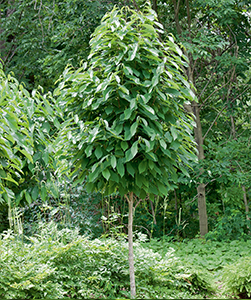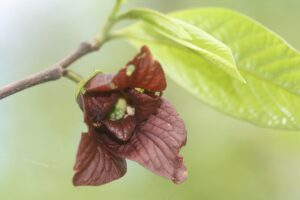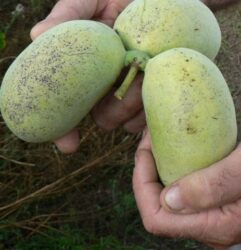By Bernheim
 Asimina triloba, commonly referred to as the Pawpaw, is a deciduous fruit tree native to the eastern, southern, and mid-western United States. Pawpaw is one of the northern most representatives of its family, Annonaceae, as most relatives are focused in tropical regions. The common name is likely a variation of Papaya given by English speakers in the Caribbean who related the large leaves and fruit of the Papaya (Carica) to that of Papaw (Asimina). According to William Werthner in his 1935 book, “Some American Trees,” the formal Asimina is a Latinized version of the Native American word “assimin,” where triloba describes the three-parted Calyx (collection of sepals) as well as the three-parted Corolla (collection of petals).
Asimina triloba, commonly referred to as the Pawpaw, is a deciduous fruit tree native to the eastern, southern, and mid-western United States. Pawpaw is one of the northern most representatives of its family, Annonaceae, as most relatives are focused in tropical regions. The common name is likely a variation of Papaya given by English speakers in the Caribbean who related the large leaves and fruit of the Papaya (Carica) to that of Papaw (Asimina). According to William Werthner in his 1935 book, “Some American Trees,” the formal Asimina is a Latinized version of the Native American word “assimin,” where triloba describes the three-parted Calyx (collection of sepals) as well as the three-parted Corolla (collection of petals).
The eventual use of Pawpaw to describe Asimina triloba began as early as the 1760’s. Various nicknames exist for the fruit, often bearing ‘banana’ or ‘mango’ to relate the familiar taste of tropical fruits to that of the pawpaw. Some notable titles include “Kentucky banana” and “hillbilly mango”. This flavor pallet is all too familiar to those that seek out and enjoy this native fruit.
 The leaves are simple, obovate (shaped like the long section of an egg with the narrower end at the base), and arranged alternately at the ends of the stems. Chemical compounds (acetogenins) within the leaves and stems repel insects, showing potential for homeowners to add native fruits to their landscapes without bringing additional pests. Leaves begin to change color mid-September becoming rusty-yellow and spotted; this allows passersby to identify the colonies from a distance. However, to procure the fruit from these trees, one must locate the colony before our autumnal indicator begins.
The leaves are simple, obovate (shaped like the long section of an egg with the narrower end at the base), and arranged alternately at the ends of the stems. Chemical compounds (acetogenins) within the leaves and stems repel insects, showing potential for homeowners to add native fruits to their landscapes without bringing additional pests. Leaves begin to change color mid-September becoming rusty-yellow and spotted; this allows passersby to identify the colonies from a distance. However, to procure the fruit from these trees, one must locate the colony before our autumnal indicator begins.
 The fruit is large and pale green, ripening to bluish-green with dark browns and yellows. Fruit develops from flowers that do not produce typical chemical signatures, rather emitting the odor of rotting meat or yeast. Peculiar indeed, pollinators can include flies and beetles. Harvest for pawpaw occurs between late-august and early-October, when ripe fruits fall off the tree and make themselves available to hungry woodland creatures. These fruits are thought to have been spread throughout North America by then-existing megafauna (large animals) and more recent history shows humans involvement in dispersal. Unripe/underdeveloped fruit are starchy and hard to the touch, maturing on the tree to full ripeness. Ripe fruit is extremely aromatic, soft, and fragile. Quick ripening and splotchy coloration disqualify this incredible native fruit from grocery store shelves.
The fruit is large and pale green, ripening to bluish-green with dark browns and yellows. Fruit develops from flowers that do not produce typical chemical signatures, rather emitting the odor of rotting meat or yeast. Peculiar indeed, pollinators can include flies and beetles. Harvest for pawpaw occurs between late-august and early-October, when ripe fruits fall off the tree and make themselves available to hungry woodland creatures. These fruits are thought to have been spread throughout North America by then-existing megafauna (large animals) and more recent history shows humans involvement in dispersal. Unripe/underdeveloped fruit are starchy and hard to the touch, maturing on the tree to full ripeness. Ripe fruit is extremely aromatic, soft, and fragile. Quick ripening and splotchy coloration disqualify this incredible native fruit from grocery store shelves.
Bernheim Arboretum and Forest is home to countless colonies of pawpaw that are utilized by native wildlife for nourishment and develop the understory of many areas within our protection. Asimina triloba has even been introduced and labeled within the Arboretum. Visitors can find two specimens located and labeled in the Children’s Play Garden, a perfect location for a useful native to be on display for all to see and experience.
 In 2019, Bernheim celebrates 90 years of connecting people with nature. At over 25 square miles, Bernheim is the largest privately held forest dedicated to conservation and education in the region. Our arboretum is home to plant collections of over 8,000 varieties, public art, and educational programming for thousands of students. Our pristine forest hosts hikers and outdoor adventures alongside research and conservation projects which will serve to protect the environment for future generations.
In 2019, Bernheim celebrates 90 years of connecting people with nature. At over 25 square miles, Bernheim is the largest privately held forest dedicated to conservation and education in the region. Our arboretum is home to plant collections of over 8,000 varieties, public art, and educational programming for thousands of students. Our pristine forest hosts hikers and outdoor adventures alongside research and conservation projects which will serve to protect the environment for future generations.
As a 100% member and donor supported organization, we could not fulfill this important mission without you. We hope you’ll continue to support our efforts throughout the next 90 years. Join or donate by clicking here.

